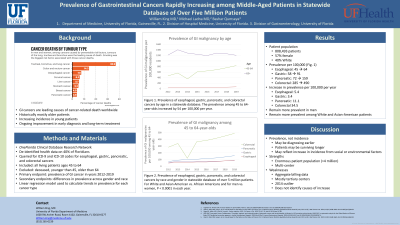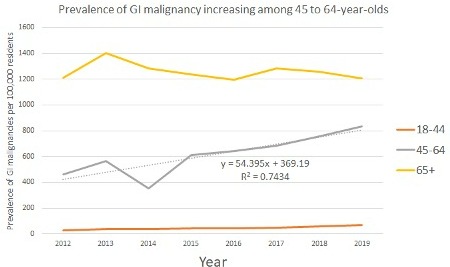Back


Poster Session B - Monday Morning
Category: Colorectal Cancer Prevention
B0176 - Prevalence of Gastrointestinal Cancers Rapidly Increasing Among Middle-Aged Patients in Statewide Database of Over Five Million Patients
Monday, October 24, 2022
10:00 AM – 12:00 PM ET
Location: Crown Ballroom

Has Audio

William W. King, MD
University of Florida
Gainesville, FL
Presenting Author(s)
William W. King, MD, Michael Ladna, MD, Bashar Qumseya, MD, MPH
University of Florida, Gainesville, FL
Introduction: Colorectal, gastric, esophageal and pancreatic cancers account for the 2nd, 3rd, 6th and 7th leading causes of cancer-related death worldwide, respectively. Gastrointestinal cancers have historically affected primarily older patients but may have become more common among younger patients in recent years. We assessed the prevalence of gastrointestinal cancers in Florida using a large database of over five million patients.
Methods: We extracted de-identified data from the OneFlorida Clinical Data Research Network, an electronic data repository that encompasses more than 40% of Floridians. We queried the database for ICD-9 and ICD-10 codes for esophageal, gastric, pancreatic, and colorectal cancers and collected demographic data on the patients. The primary outcome was the prevalence of GI cancers over time. For each year, the prevalence was calculated as the total number of patients who carry the diagnosis divided by the total number of patients in the population. The number was adjusted for each 100,000 patients. We used linear regression models to assess trends over time.
Results: Between 2012 and 2019, 4.2 million to 5.4 million patients were identified each year. The 2019 cohort was comprised of 57% female, 40% White race, and 808,493 patients between ages 45 and 64 (here defined as middle age). The prevalence per 100,000 residents for this patient group rose from 49 to 94 for esophageal, 58 to 91 for gastric, 72 to 159 for pancreatic, and 285 to 490 for colorectal cancers (Figure 1). According to the linear regression model, the combined prevalence of all four gastrointestinal malignancies among 45 to 64-year-olds increased by an average of 54 per 100,000 per year. Colorectal increased by 34.5 per 100,000, pancreatic by 11.1, gastric by 3.4, and esophageal by 5.4.
All cancers were significantly more common in men than in women in all years, most recently 406 vs 269 (p < 0.0001) in 2019. They were also more prevalent among white and Asian American patients than among African Americans or Native Americans (378 and 363 vs. 222 and 190, respectively, P < 0.0001).
Discussion: The prevalence of esophageal, gastric, pancreatic, and colorectal cancers is increasing among middle-aged adults. Diagnosis remains more common in men, as well as in Asian American and White populations. These trends may be due to social or environmental factors increasing the incidence of GI cancers or to improved diagnostic techniques facilitating earlier diagnosis of existing malignancy.

Disclosures:
William W. King, MD, Michael Ladna, MD, Bashar Qumseya, MD, MPH. B0176 - Prevalence of Gastrointestinal Cancers Rapidly Increasing Among Middle-Aged Patients in Statewide Database of Over Five Million Patients, ACG 2022 Annual Scientific Meeting Abstracts. Charlotte, NC: American College of Gastroenterology.
University of Florida, Gainesville, FL
Introduction: Colorectal, gastric, esophageal and pancreatic cancers account for the 2nd, 3rd, 6th and 7th leading causes of cancer-related death worldwide, respectively. Gastrointestinal cancers have historically affected primarily older patients but may have become more common among younger patients in recent years. We assessed the prevalence of gastrointestinal cancers in Florida using a large database of over five million patients.
Methods: We extracted de-identified data from the OneFlorida Clinical Data Research Network, an electronic data repository that encompasses more than 40% of Floridians. We queried the database for ICD-9 and ICD-10 codes for esophageal, gastric, pancreatic, and colorectal cancers and collected demographic data on the patients. The primary outcome was the prevalence of GI cancers over time. For each year, the prevalence was calculated as the total number of patients who carry the diagnosis divided by the total number of patients in the population. The number was adjusted for each 100,000 patients. We used linear regression models to assess trends over time.
Results: Between 2012 and 2019, 4.2 million to 5.4 million patients were identified each year. The 2019 cohort was comprised of 57% female, 40% White race, and 808,493 patients between ages 45 and 64 (here defined as middle age). The prevalence per 100,000 residents for this patient group rose from 49 to 94 for esophageal, 58 to 91 for gastric, 72 to 159 for pancreatic, and 285 to 490 for colorectal cancers (Figure 1). According to the linear regression model, the combined prevalence of all four gastrointestinal malignancies among 45 to 64-year-olds increased by an average of 54 per 100,000 per year. Colorectal increased by 34.5 per 100,000, pancreatic by 11.1, gastric by 3.4, and esophageal by 5.4.
All cancers were significantly more common in men than in women in all years, most recently 406 vs 269 (p < 0.0001) in 2019. They were also more prevalent among white and Asian American patients than among African Americans or Native Americans (378 and 363 vs. 222 and 190, respectively, P < 0.0001).
Discussion: The prevalence of esophageal, gastric, pancreatic, and colorectal cancers is increasing among middle-aged adults. Diagnosis remains more common in men, as well as in Asian American and White populations. These trends may be due to social or environmental factors increasing the incidence of GI cancers or to improved diagnostic techniques facilitating earlier diagnosis of existing malignancy.

Figure: Figure 1. Prevalence of esophageal, gastric, pancreatic, and colorectal cancers by age in a statewide database. The prevalence among 45 to 64-year-olds increased by 54 per 100,000 per year.
Disclosures:
William King indicated no relevant financial relationships.
Michael Ladna indicated no relevant financial relationships.
Bashar Qumseya indicated no relevant financial relationships.
William W. King, MD, Michael Ladna, MD, Bashar Qumseya, MD, MPH. B0176 - Prevalence of Gastrointestinal Cancers Rapidly Increasing Among Middle-Aged Patients in Statewide Database of Over Five Million Patients, ACG 2022 Annual Scientific Meeting Abstracts. Charlotte, NC: American College of Gastroenterology.
